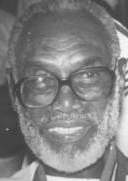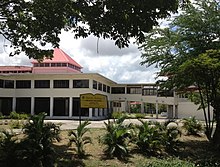
Georgetown is the capital and largest city of Guyana. It is situated in Demerara-Mahaica, region 4, on the Atlantic Ocean coast, at the mouth of the Demerara River. It is nicknamed the "Garden City of the Caribbean." It is the retail, administrative, and financial services centre of the country, and the city accounts for a large portion of Guyana's GDP. The city recorded a population of 118,363 in the 2012 census.

The University of Guyana, in Georgetown, Guyana, is Guyana's national higher education institution. It was established in April 1963 with the following Mission: "To discover, generate, disseminate, and apply knowledge of the highest standard for the service of the community, the nation, and of all mankind within an atmosphere of academic freedom that allows for free and critical enquiry."
Martin Wylde Carter was a Guyanese poet and political activist. Widely regarded as the greatest Guyanese poet, and one of the most important poets of the Caribbean region, Carter is best known for his poems of protest, resistance and revolution. He played an active role in Guyanese politics, particularly in the years leading up Independence in 1966 and those immediately following. He was famously imprisoned by the British government in Guyana in October 1953 under allegations of "spreading dissension", and again in June 1954 for taking part in a People's Progressive Party (PPP) procession. Shortly after being released from prison the first time, he published his best-known poetry collection, Poems of Resistance from British Guiana (1954).
St. Stanislaus College is a Grade-A senior secondary school in Georgetown, Guyana. It has a student population of 500 and a teaching staff of about 40. Admission to the school is normally through the Secondary Schools' Entrance Examination. It is the third highest school in the country, following Queen's College and Bishops' High School.
Arthur James Seymour, or A. J. Seymour, was a Guyanese poet, essayist, memoirist, and founding editor of the literary journal Kyk-Over-Al.

David Arthur Granger is a retired military officer who served as the 9th President of Guyana from May 2015 to August 2020. He served for a time as Commander of the Guyana Defence Force and subsequently as National Security Adviser from 1990 to 1992. He was Leader of the Opposition in the National Assembly of Guyana from 2012 to 2015.

Georgetown City Hall is a nineteenth-century Gothic Revival building located on the corner of Regent Street and Avenue of the Republic in Georgetown, Guyana. The building was designed by architect Reverend Ignatius Scoles in 1887, and was completed in June 1889. The building houses the offices of the Mayor, the City Council, and the City Engineer.
Jan Rynveld Carew was a Guyana-born novelist, playwright, poet and educator, who lived at various times in The Netherlands, Mexico, England, France, Spain, Ghana, Jamaica, Canada and the United States.

Moses Veerasammy Nagamootoo is a Guyanese politician, writer and novelist who served as the Prime Minister of Guyana under former President David A. Granger from May 2015 to August 2020.
Clem Seecharan is a writer and historian of the Indo-Caribbean experience, and of West Indies cricket, who was born in Guyana and has been based in England since 1986.

Education in Guyana is provided largely by the government of Guyana, through the Ministry of Education and its arms in the ten different regions of the country. Guyana's education system is a legacy from its time as British Guiana, and is similar to that of the other anglophone member states of the Caribbean Community, which are affiliated to the Caribbean Examinations Council (CXC). School curricula, funding, standards and other policies are set by the central government and implemented through the Ministry of Education and related agencies. The Education System is divided into eleven districts, ten of which correspond to the national administrative and geographical regions of the country, while the capital, Georgetown, is treated as a separate education district. With 8.3% of its GDP spent on education, Guyana sits with Cuba, Iceland, Denmark and Botswana as among the few countries with top spending on education.
Sir Fenton Ramsahoye, QC, SC was a Guyanese lawyer and politician who served for over twenty years in Antigua and Barbuda.

Lord William Piercy Austin was the inaugural and long serving Bishop of Guyana from 1842 until his death.

Barbados–Guyana relations refers to the current and historical relationship between Barbados and the Co-Operative Republic of Guyana. The former maintains non-resident diplomatic representation from Bridgetown, while Guyana which prior had a High Commissioner to Barbados appointed its first resident Consul-General, Michael Brotherson to Bridgetown in January 2012.

Ptolemy Alexander Reid was a Guyanese veterinarian and politician who served as Prime Minister of Guyana from 1980 to 1984.
Sister Mary Noel Menezes OR was a Guyanese Roman Catholic nun and historian. She was involved with the University of Guyana from 1967 to her death in 2022, as a lecturer, head of department, full professor, and professor emeritus. She specialised in Guyanese history, particularly that of Amerindians and Portuguese Guyanese.

Mohamed Irfaan Ali is a Guyanese politician and the president of Guyana. Ali is the first Muslim president of Guyana, along with being the second Muslim head of state in the Americas after Noor Hassanali.

Valerie Muriel Rodway was a Guyanese composer of cultural and patriotic songs, inspired by the events leading up to Guyana's independence in 1966. She is best known for composing music to accompany Guyana national poetry, like Arise, Guyana, Kanaïma, and the Martin Carter's Guyanese Independence poem Let Freedom Awaken. For the next two decades, school children were taught the songs she and others composed to inspire patriotism and cultural affinity. She selected the poetry for her compositions based upon her principles and values, first developed among her parents and siblings.

Lynette DolphinMBE, LRAM, GRSM, ARCM, CCH worked for 60 years in the fields of music education and Guyana culture. She was a musician, an educator at Queen's College, Guyana for 25 years, and a chair of the Guyana Department of Culture, later called the National History and Arts Council. She established prominent music festivals and was a co-founder of the Guyana Music Teachers' Association. Dolphin was director of the Caribbean Festival of Arts (Carifesta). She compiled six books of songs for schools.













